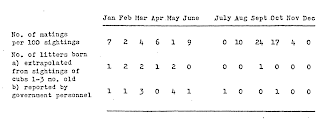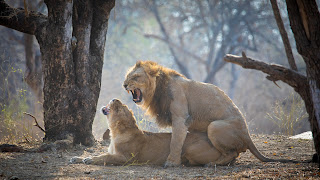This Achaemenid cylinder seal, found in Iran and dated to the 6th–4th century BC is currently kept in the Met Museum.
Now the scene depicted on this seal could be just an "ordinary king hunting a lion" scene 🙂 Although I already asked a question whether there is anything ordinary about the Persian king's obsession with lion hunting in my article "Sacred hunt"...
And in my article "King killing Angra Mainyu" I explained why I think that this was most likely a ritual in which the king imitated the rain (and war) god Ninurta/Ningirsu killing Nergal...Or "winter rain storms" ending "summer drought"...Which ever you like best...
So why lion and boar? Here's what I think:
Lion and boar are animal calendar markers depicting two halves of the climatic year:
Boar - cool, wet half of the year (Nov-Apr)
Lion - hot, dry half of the year (May-Oct)
I talked about these symbols in my article "Admetus" about Apollo and the chariot pulled by boars and lions...
Lion is the symbol of autumn (Aug,Sep,Oct)...Why? Cause the peak mating season of the Eurasian lions starts in Aug and spans the whole autumn...
Boar is the symbol of winter (Nov,Dec,Jan)...Why? Cause the peak mating season of the Eurasian boar starts in Nov and spans the whole winter...
I talked about the meaning of boar and lion as animal calendar markers, this time in Bactria, in my article "Summer and winter BMAC seals"...
In Mesopotamia, autumn is the hottest, driest part of the year. The time of death...And the ruler of the season of death was Nergal, "the destructive sun", the god of death, who was imagined as a lion...I talked about this in my article "Winged super human hero"...
The summer, the season of death, which starts when lions start to mate, ends when the first rains arrive in Nov...When boar start to mate...Making lions and boar the natural enemies...Like on this Elamite axe head with Lion (Autumn) and Boar (Winter)...I talked about this in my article "Double headed eagle"...
But there is another thing that happens in Nov...Vultures, whose mating season, which spans winter months (Nov, Dec, Jan), begin their courtship aerial displays, where the pairs fly together over one another with outstretched wings...
I talked about this in my article "Double headed eagle". Like this double headed eagle dude from a Bactrian axe dated to 2500-1500 BC.
Why double headed eagle? Cause the vultures performing this aerial dance look like this from the ground...
The beginning of the Vultures mating season coincides with the beginning of the cool wet season (Nov-Apr), the rain and snow season in Mesopotamia and surrounding mountain areas to the north and east...
Which is why the old "agricultural" rain god, Ninurta/Ningirsu was originally imagined as a huge eagle with spread wings... I talked about him as a bird man in my article "Judgement of the birdman"...
But Ninurta was also imagined as an archer. Here depicted killing the blazing sun...Ninurta, the hunter, the guy with the bow and arrow...Killing The Blazing Sun (Nergal)...Sagittarius...Which marks the same moment in the solar year...The end of the half of the year dominated by the sun...The Irish will love this. Remember Balor?
I think he is the dude holding the bow on the famous Adda seal. I talked about this seal in my article "Adda seal"...
So here we come to the first interesting question: is the archer depicted on the seal Ninurta killing the deadly late summer sun which causes drought? Or is the archer a king, imitating Ninurta, killing a lion, symbol of deadly late summer sun, Nergal?
And the second interesting question: All this boar, lion, archer stuff is happening under the watchful eye of the Faravahar (the flying dude), basically a man riding on a huge bird (eagle) with spread wings...Hmmmm...
The meaning of Faravahar is unclear...Some say that this is Ahura Mazda...But that is disputed...
Some say that this is actually a symbol of Ashur, the Supreme god of Assyrians, which Pesians borrowed later.
Just wandering...Do we actually have any written source identifying this flying dude with a bow as Ashur? I don't think so, considering that there is still a dispute what the meaning of this symbol is...
We actually don't know if Ashur was ever depicted. But if he was, this could be one of his depictions. You know one of his names was "Great mountain"...
You see how his skirt was made to look like a mountain? I wrote about this artefact in my article "Assur"...
So is the flying dude Ninurta/Ningirsu, the eagle/archer in another guise? I mean Ninurta was a super important to the Assyrians...
When king Assurnasirpal II moved the Assyrian capital city to Kalhu, the first temple he built was for Ninurta, whom he addressed as: "...the strong, the almighty, the exalted, foremost among the gods, the splendid (and) perfect warrior..."
And as I said, Ninurta was most often depicted holding a bow. Actually bow is his identifying feature. Like on this 8th-century stone carving from Assur, on which a bare-headed king worships a god holding a bow, "thought to be Ninurta". Currently in the British Museum...
If I was a warlike Assyrian, I would want Ninurta, the war and storm god, "the perfect warrior" to be my god...
And as I said, Ninurta/Ningirsu was originally a storm god who was first imagined as a storm bird with outstretched wings...Storm bird that brings the rain to the desert land of Mesopotamia...
If this winged dude is actually Ninurta, the deified storm bird, that would explain why we see this symbol so often hovering over the tree of life...It is the rain that the storm bird (storm god) brings, which supports (tree of) life in Mesopotamia...
Oh look, "winged genies" standing on both sides of the tree of life...I talked about the origin of the Assyrian Eagle dudes and their (possible) meaning in my article "Eagle dude from Alepo"...
But the Eagle dudes were found in the area of Mesopotamia/Iran/Central Asia since Neolithic...
So, now, after saying all this, I will backpaddle here and say that I actually believe that the flying dude is Ahura Mazda...As well as Ninurta...And I will explain why I think so soon...
Until then...

























I love your posts, I just want to add that the basket is also thought to be a bucket of water, whereas the pinecone was used as a multiple (purifier)to sprinkle water onto the tree of life. It could be this is the seasonal rains that sustain the tree, or that the doorway is being symbolically purified, as it marked a threshold between worlds. It's suggested that Assyrian temples had a cosmological arrangement so that the gates could be seen as the entrance to the other world. Thresholds were commonly purified, in Rome during the festival of Janus the Tigillum sororium was purified to prevent the entrance of bloodthirsty Striges' and many other examples.
ReplyDeleteThanks. I was made aware of this too. And this fits perfectly, as the pinecones harvest season coincides with the rain season in the area...
Delete